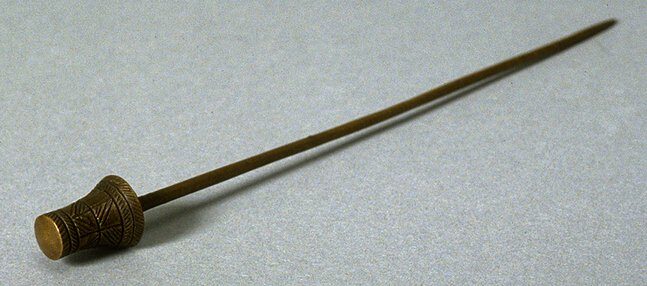Hairpin
Kuba

Description
Subject Matter:
Kuba artists apply their bold and sophisticated surface design to both ceremonial and everyday objects alike. Objects such as drums, boxes, stools, backrests, knives, swords, bangles, wisdom baskets, staffs and fly whisks were typically reserved for the king and his courtiers. However, these objects in addition to cups, rubbing oracles, pipes, combs, drinking horns, ritual spoons, and scepters also served specific religious and ceremonial functions, or were simply everyday objects for common use. Whether they were related to prestige, used as divination objects to protect the community or simply served as conversation pieces for decoration, the commonality these objects often share are the elaborate geometric patterning and lavish surface design.
Brass and copper hairpins were typically associated with a higher status. Often, they were worn through a dome shaped hat called a laket. The geometric patterns on this particular hairpin are similar to patterns found on Kuba textile, basketry, sculpture, and female body scarifications. Patterns may be given names, but the same pattern will likely be given a different name by different people.
References:
Daniel Biebuyck, The Arts of Zaire, 1985
Georges Meurant, African Textiles from the Kingdom of Kuba, 1986
Roy Sieber, African Textiles and Decorative Arts, 1972
Jan Vansina, The Children of Woot, 1978
Physical Description:
Pin with designed pinhead. Pinhead has a cylindrical shape with a flat cap. The base of the pinhead slightly flares out. The pinhead is engraved with rectilinear designs.
Usage Rights:
If you are interested in using an image for a publication, please visit https://umma.umich.edu/request-image/ for more information and to fill out the online Image Rights and Reproductions Request Form.